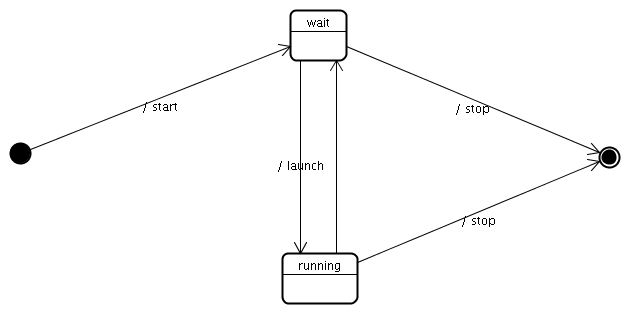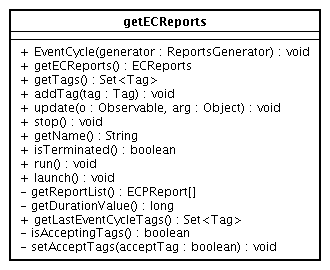
According to the EPC Standard, an EventCycle is the smallest unit of interaction between an ALE client and an ALE implementation through the ALE reading API. An EventCycle is an intervall of time during which tags are read.
This document shall provide an overview to the implementation of an EventCycle in the Fosstrak ALE.
The EventCycle is implemented as a thread. After creation the thread waits on the EventCycles monitor.
synchronized (this) {
try {
this.wait();
} catch (InterruptedException e) {
e.printStackTrace();
}
}
When there are subscribers for the EventCycle the ReportsGenerator launches the EventCycle through the launch method.
// Code fragment from ReportsGenerator eventCycle.launch();
This call will set the EventCycle to the running state
this.running = true;
synchronized (this) {
this.notifyAll();
}
The EventCycle runs as long as specified by the duration value. The reports are generated and sent through the ReportsGenerator to the subscribers.
After some cleanup and preparations for the next EventCycle the EventCycle sets itself sleeping and waits for the next launch call.
try {
synchronized (this) {
this.wait();
}
} catch (InterruptedException e) {
e.printStackTrace();
}
An EventCycle is constructed according to an EventCycle specification (called ECSpec). The ECSpec specifies several parameters. The most important ones are the time intervall during which tags are read and the readers where tags shall be collected.
Whenever a client defines a new EventCycle through the ALE interface, a new ReportsGenerator will be created along an EventCycle. The ReportsGenerator acts as a gateway to the EventCycle for clients. A client does not subscribe on an EventCycle but on the associated ReportsGenerator. The ReportsGenerator ensures that the EventCycle is started/stopped and that subscribers (clients) receive the resulting tags.
Upon creation the EventCycle aquires the readers from the logical reader API and registers as an Observer. The EventCycle does not accept tags yet.
// code piece from the EventCycle constructor setAcceptTags(false);
As soon as a client subscribes for an EventCycle, the ReportsGenerator starts the demanded EventCycle. Tags are now accepted by the EventCycle.
When the specified duration (EventCycle duration) is over the EventCycle is stopped and the tags are distributed to the clients by the ReportsGenerator. The tag-filtering is performed by the class Reports.
ECReports ecReports = getECReports(); // notifySubscribers generator.notifySubscribers(ecReports);
In case where the EventCycle is not repeating (this means that one EventCycle does not run multiple times) all readers are deregistered and the EventCycle is destroyed together with its ReportsGenerator. This is preformed by a call to the stop() method.
The following sequence diagram shall visualize the behaviour of an EventCycle. The dashed lines are asynchronous calls whereas the solid lines denote synchronous calls.
1: A client defines a new EventCycle through the ALE.
1.1: The ALE checks if this EventCycle already exists. In the present case there is no such EventCycle an therefor the ALE creates a new ReportsGenerator.
1.1.1: The ReportsGenerator creates a new EventCycle.
1.1.1.1/2/3: The EventCycle retrieves the readers specified in the ECSpec from the LogicalReaderManager.
2: The Client subscribes for an EventCycle.
2.1: The ALE subscribes the Client on the ReportsGenerator.
2.1.1: The ReportsGenerator starts the EventCycle. The EventCycle now processes tags from the readers.
3/4/5: The LogicalReader(s) add Tags to the EventCycle.
6: When the EventCycle reaches its boundaries the reports are generated and sent back to the Client (through the ReportsGenerator).
7: The Client wants to unsubscribe from an EventCycle.
7.1: The ALE calls the unsubscribe-method on the corresponding ReportsGenerator.
8: The Client undefines an EventCycle.
8.1: The ALE stops the corresponding ReportsGenerator
8.2: The ReportsGenerator stops the EventCycle

The following state diagram shall visualize the states of an EventCycle.
The EventCycle is initially null. A ReportsGenerator creates the EventCycle and starts it (Transition to the wait-state). Then a subscription for this EventCycle arrives and the EventCycle is launched (Transition to running state). After the cycle is over the EventCycle returns into the wait-state. When an undefine occurs the EventCycle moves into the stopped final state and becomes destroyed.

The following class interface gives an overview to the methods available from the EventCycle.
